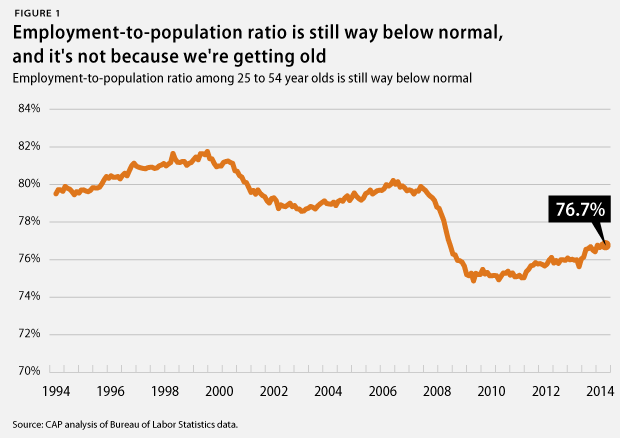This column was originally published on MarketWatch.
Friday’s jobs report for September was a crowd pleaser. In the Bureau of Labor Statistics, or BLS, numbers, there was something for everyone: employers reported 248,000 total jobs added, the unemployment rate fell from 6.1 percent to 5.9 percent, there were strong upward revisions to previous months’ jobs figures, and we saw strong gains among ethnic groups that have been left out of the recovery so far. We can all take heart in an improving real economy, and Federal Reserve watchers will be pleased to know this comes without signs of wage pressures. While the pace of job growth ticked up, the report is actually strongest beneath the top line numbers.
Starting with August’s report, where revised data added 38,000 jobs to a disappointing report, additional revisions added another 31,000 new jobs to the economy in July. The three-month average job growth is now 224,000 jobs. It is a reflection of both how bad the recession was and how well the economy is performing today that job gains are still strengthening more than five years since the official end of the recession.
We saw much broader strength in the economy with this report than in recent ones. It’s true that the employment-to-population ratio was flat overall at 59 percent, but if you control for age, the share of people who are working age and have jobs was significantly higher at 76.7 percent.
Arguably, the strongest signs for the economy come from demographic breakdowns in the BLS report’s household survey. Latinos and African Americans saw significant reductions in unemployment rates while the labor-force participation for both groups grew significantly. In September, Latinos gained 173,000 jobs, and their unemployment rate fell from 7.5 percent to 6.9 percent. African Americans made even stronger gains, with 288,000 jobs gained and a fall in the unemployment rate from 11.4 percent to 11 percent. The share of the African American population with jobs increased by nearly 1 full percentage point, from 54 percent to 54.9 percent, a truly striking gain for a single month.
Not only is this welcomed relief for two groups that have struggled during the recovery with unemployment rates much higher than the population as a whole, it’s good news for the entire labor market. Both African Americans and Latinos are younger than the population as a whole, and the fact that job gains are starting to affect these younger groups is an important indicator that the labor market is becoming more robust.
Does this mean mission accomplished? Not for a while.
Economists from the left and right—along with reporters—pointed to the percentage of working-age Americans without jobs and the tepid wage growth seen in Friday’s numbers as a sign of considerable slack remaining in the labor market.

Unfortunately, economists, journalists, and pundits are not the same as Congress—where gridlock, along with austere budgets, continues to make the Federal Reserve’s job harder. The fact of the matter is monetary policy will be both the accelerator and the brakes on the economy for a while longer.
The depth of the recession remains a challenge for the Federal Reserve, which must weigh an economy that added almost one-quarter-million jobs last month against an army of unemployed estimated at more than 6.3 million—on top of the 9.3 million people officially counted as unemployed. This is why the Fed is less hawkish about inflation than it otherwise would be with today’s unemployment rate and why it’s now using a much broader set of labor-market indicators to judge when the recovery warrants tighter money.
For workers, the good news is that hiring really is picking up steam, and the Fed isn’t—and shouldn’t be—hitting the brakes. However, the bad news is that we don’t see any signs of wage pressure and shouldn’t expect wage increases anytime soon, especially with this many prime-aged workers on the sidelines. Absent action from lawmakers, we will need a string of job reports like this one before we see wage growth start to reach most Americans, which is a real problem for an increasingly squeezed middle class.
Make no mistake, this is the best jobs report that we have had in a while, and it’s reassuring to see job creation strengthening for all Americans. But this is what a well-run economy is supposed to look like in normal times. For policymakers to do anything to slow things down in the short-term would be more than tone deaf; it would be irrational.
Michael Madowitz is an Economist at the Center for American Progress.